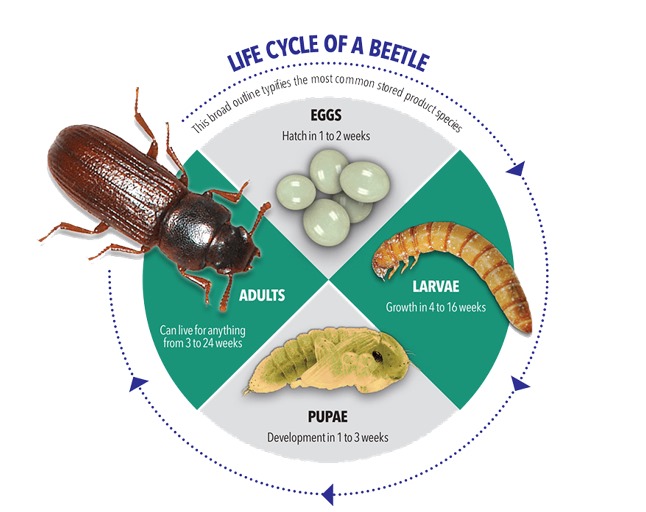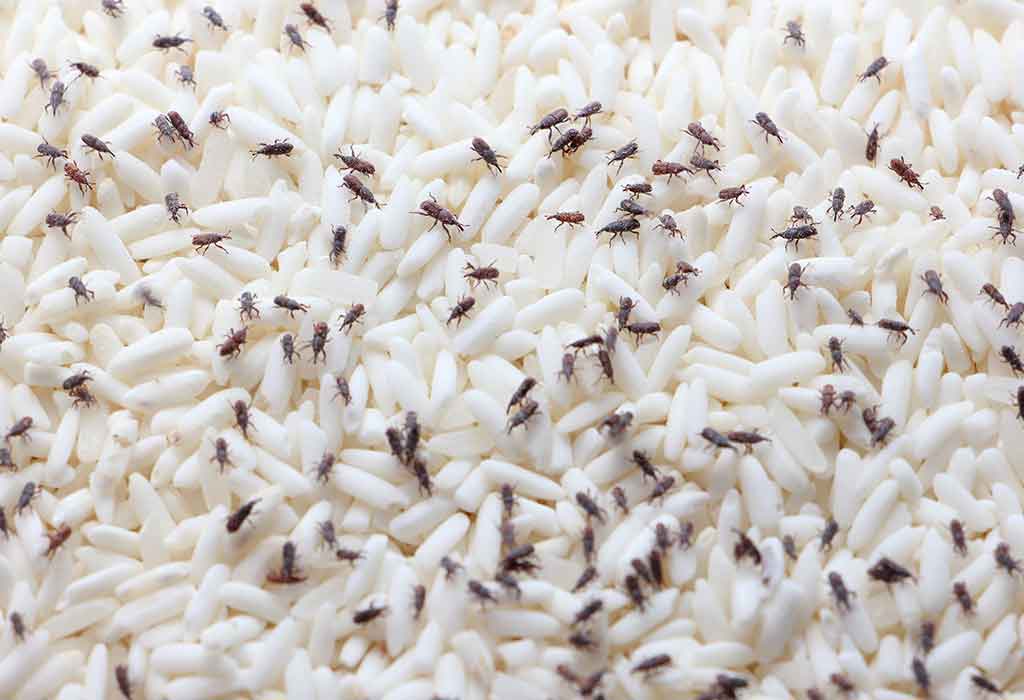A week after buying a bag of rice from a trusted store, I opened it only to find tiny insects crawling through the grains. The bag was properly closed, stored in a clean, dry place, and there were no signs of pests anywhere else in my kitchen. Yet somehow, an infestation appeared out of nowhere!
I remembered a thought I’d once had, and I’m sure it has crossed many people’s minds at some point: Do insects in stored grains really come from nowhere? Could they just form inside the food on their own?!
Finding insects in stored grains isn’t a rare case. Many people have had the same issue with rice, flour, oats, and other dry grains. And according to studies, nearly 20% of the world’s stored grains are lost due to insect infestation, and in some places, that number is even higher.
“Insect pests currently consume the equivalent of 1 out of every 12 loaves of bread (before it ever gets made). By the end of this century, if climate change continues unabated, insects will be eating more than 2 loaves of every 12 that could have been made”, said Curtis Deutsch, the researcher and co-author at the University of Washington, to BBC News.
So, where do these insects come from? And more importantly, can we prevent them from invading our food?
How do Insects in Stored Grains get into the Sealed Bags?
Even if the bag looks perfectly fine at first, and you’ve stored it in a clean, dry place, insects can still find their way in or even chew their way through.
Some types, like the larvae of Indian meal moths, are known to bite through thin plastic, cardboard, and paper packaging just to reach the food inside. And for other insects, a tiny hole in the package or even a gap between the container and its lid is more than enough. Another thing is that if there’s already an infested item nearby, it’s very easy for insects to move from one bag to another.
What makes things worse is that most insects in stored grains thrive in warm, humid environments, like a kitchen shelf in summer. If the cupboard isn’t cleaned regularly, with bits of rice, flour, or crumbs lying around, it becomes even more inviting. And while we usually think they feed only on grains, some species can survive on dried fruit, spices, pet food, and even the cardboard packaging itself!
But what if you did everything right, and the insects still appeared?
You kept the grains in a properly sealed container, stored them in a dry cupboard, and made sure your kitchen was clean; there were no tears, not even a tiny hole; however, weeks later, you found insects inside.
So, how did insects in Stored Grains penetrate the container and get in there?
You might be surprised, but some insects in stored grains don’t even need to break in; their eggs were hidden in the grains long before you bought them home! Certain species of insects – such as weevils, grain moths, and some types of beetles- lay their eggs directly inside grains or seeds during storage, transport, or even earlier at the harvesting stage.
If proper pest control methods aren’t applied early on, or if the grains aren’t thoroughly cleaned and inspected during packaging, those eggs can end up sealed inside the bag. And then you buy one of those bags that seem perfectly clean to you, but that doesn’t mean they’re egg-free.
Eggs of grain insects are incredibly small. They are also white, translucent, and nearly invisible to the naked eye. They remain in the bag, hidden inside the grains, until conditions become favorable (such as warmth and humidity). At that point, the eggs hatch into larvae that feed on the grain from within, then pupate and eventually emerge as adult insects: the stage most people finally notice.

So, by the time you bought that sealed bag, it was already carrying invisible eggs inside the grains, waiting for the right conditions to hatch and cause an insect infestation later. Not because your food went bad or your kitchen wasn’t clean, but simply because the eggs were there all along.
The Following are some Useful Tips to Keep Insects Out of Your Food!
Start with Smart Shopping
Before grains even enter your kitchen, inspect packaging carefully. Look for small holes, clumped grains, or fine powder—these subtle signs can hint at hidden pests. Choose stores with high product turnover, where items move quickly off shelves. The less time a bag sits in storage, the lower the chance of infestation. If possible, opt for brands known for strict quality control during packaging.
At Home: Freeze First and Store Right
Once you bring grains home, an easy trick is to freeze them for 3–4 days. This kills any undetected eggs or larvae without affecting quality. After freezing, transfer the grains to airtight containers made of glass, metal, or thick plastic. Flimsy materials like cardboard or thin sacks are easy targets for r insects in stored grains; they can chew through or sneak into gaps. A tight seal is always your best defense.

Maintain a Pest-Resistant Pantry
Store containers in a cool, dry spot, far from moisture or spilled food remnants. Regularly wipe shelves and vacuum corners to remove crumbs that might attract pests. Practice the “first in, first out” rule: use older grains before opening new packages, and avoid bulk-buying more than you’ll use in a few months. The less time food sits unused, the fewer opportunities bugs have to settle in.
Insects already in your food? Here’s what to do!
Now that you know how to prevent future infestations, what if you’re already dealing with insects in your food? Is it still safe to eat your food while there are bugs, or should you toss it? The answer depends on a few simple factors.
It can be a bit shocking, but don’t panic; seeing insects in food doesn’t always mean the food is ruined. If you only see a few insects here and there, and the grains still look and smell normal, you can simply rinse them well and still use them. Cooking will kill any hidden larvae or eggs.
Even if you accidentally eat one, it’s not dangerous. Food safety experts say it’s not a health risk at all. In fact, there’s actually an “acceptable” limit. According to the FDA, up to 75 insect fragments are allowed per 50 grams of wheat flour!
When should you throw food/grains away?
However, there are clear signs when food should be discarded. If you find grains full of live insects, webs, or strange smells, it’s safer to throw them out. In that case, the food may have started to spoil or lose its quality.
it may also grow fungi and could contain harmful mycotoxins, which are toxic compounds that are naturally produced by certain types of molds and can cause serious health problems. What makes them even more dangerous is that many mycotoxins are heat-stable, meaning they can survive standard cooking temperatures. So, eating the grains might not be safe anymore.
After throwing the bag away, make sure to clean the area where you kept it, especially corners and hard-to-reach spots. Vacuuming is the best way to get rid of any crawling insects or tiny eggs. Then wipe the surface dry and store new grains in sealed containers. That’s the only way to make sure the problem doesn’t come back. And one last thing, never spray insecticides near your food. They don’t fix the problem, and could make the food unsafe to eat.
Insects in stored grains can be pretty annoying, even a little gross. But it’s good to know that it doesn’t take much to keep them away. With a few easy habits and a bit of attention, you can protect your food and keep your kitchen clean
So no, insects don’t magically appear out of nowhere. But if you ever find one in your rice again, at least now you know… they’ve probably been waiting for the right time to say hello!
References:
- https://extension.umn.edu/product-and-houseplant-pests/pantry-pests-insects-found-stored-food
- https://pnwhandbooks.org/insect/agronomic/farm-stored-grain/stored-grain
- https://entomology.ca.uky.edu/ef145
- https://www.mdpi.com/2304-8158/12/10/2046
- https://acopen.umsida.ac.id/index.php/acopen/article/view/10786
- https://www.theguardian.com/food/2021/may/11/how-evil-are-weevils-a-guide-to-managing-pantry-pests
- http://foodsafetytrainingcertification.com/food-safety-news/food-contamination-limits-allowed-by-law/
- https://www.maine.gov/dacf/php/gotpests/bugs/documents/indian-meal-moth-col.pdf
- https://www.saskatchewan.ca/business/agriculture-natural-resources-and-industry/agribusiness-farmers-and-ranchers/crops-and-irrigation/insects/insects-and-mould-in-stored-grain
- https://akjournals.com/view/journals/066/47/4/article-p513.xml
- https://www.bbc.com/news/science-environment-45358643
You might also like: A conversation with Dr. Muniapann about the biological invasion and pest management practices in Nepal

Salsabeel Ahmed is a science communicator with a bachelor’s degree in entomology from Alexandria University, Egypt. She is passionate about making complex scientific topics accessible and engaging. Salsabeel specializes in writing about insects and biological sciences, aiming to bridge the gap between research and everyday readers.

